Downsizing: How to Optimize your Living Space (Part 1 of 2)

We may not realize it because it has become a cultural and societal norm, but Canadians have become amongst the least living space-efficient people on earth over the past few decades. Due to market demand, it’s difficult if not impossible for Canadians to find new homes to live in which are space and cost-effective. The Globe and Mail reported in a January 2012 article entitled, Our love affair with home ownership might be doomed, that the average new house construction size in 1975 was 1,050 sq. ft., which grew to 1,950 sq. ft. as of 2010. Also notable is that the average household size fell a full person from 3.5 in 1971 to 2.5 in 2006, so houses have grown dramatically as household sizes shrink significantly.
The article also noted that in 1999, the price of a home represented 3.2 times the annual income of the owners. This grew substantially to 5.9 times income in 2010, meaning that Canadians have become more willing to spend more money on houses, even if our incomes have not increased substantially to cover the increase in house prices. As you can imagine, this is not an economically sustainable model, but it is one which many Canadians are lining up to impose upon themselves.
Controlling the Trend in Increasing Living Space
The trend of living space growth has become so unsustainable, that it appears to be stalling, if not slowly reversing. The Canadian Home Builders Association reported in 2012 that new home sizes had dropped from a mid-2000’s peak of 2,300 sq. ft. to approximately 1,900~ sq. ft. average. Unfortunately, Craig Alexander, Chief Economist of TD Bank Financial Group, believes that this trend has emerged only because cities are beginning to run out of space for larger new developments, and that “if the square footage has leveled off, it’s probably because we’re building the biggest homes we possibly can on the existing lots”, which are smaller now than in the mid-2000’s.
Related Blog: Examining Home Ownership as an Investment: With the current Canadian housing market, is it a better decision to rent or buy?
Comparing House Sizes Internationally
The average size of houses in North America is outdone only by Australia; our apartments are much larger than in Europe and Asia, as seen in the chart below detailing average overall floor-space by residence:
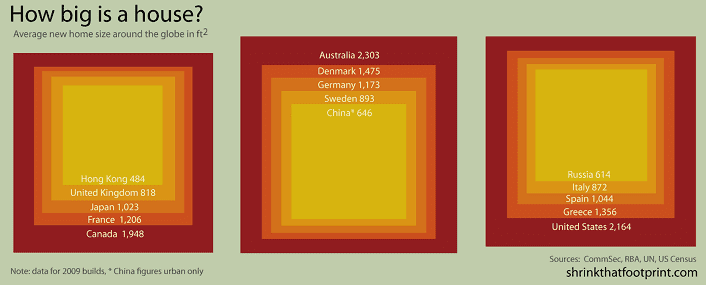

The chart below details the average sq. ft. per-household member across a range of nations, where Canada is among the least space-efficient, with nearly 800 sq. ft. per-person (for context, I live in a 600 sq. ft. apartment with my wife and a cat):
A question comes to mind: why is it that we Canadians need vastly more space per-person than residents of Europe and Asia, even if it means we are willing to take on ever-increasing levels of debt to achieve more space per-person? The answer is simple; we don’t. Refer to the chart below:
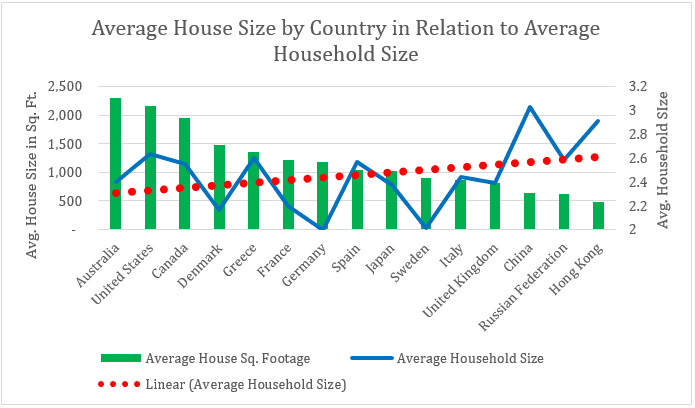
The chart above shows a general trend that nations with larger household sizes also have smaller houses on average. This trend is even more prevalent when examining average residential floor-space (including apartments) figures:
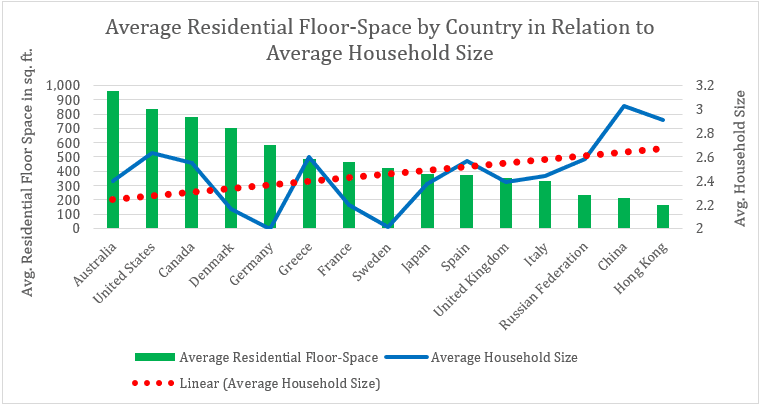
Canada’s average house size is approximately four times that of China, despite the fact that Canadian households are consistently smaller on average. This trend has been developing across North America for decades; the American Enterprise Institute (AEI) reports that today’s American homes are, on average, 1,000 sq. ft. larger than they were in 1973, with living space per-person doubling in the past 40 years:
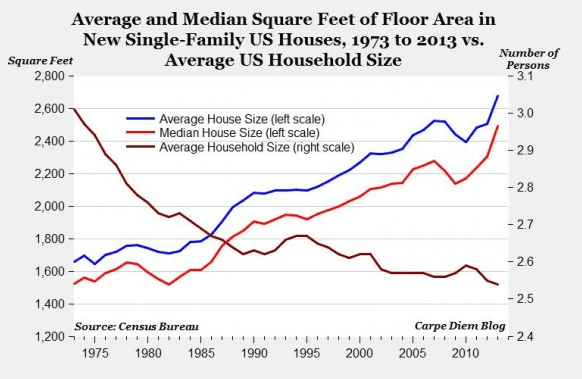
This trend reveals a certain level of inefficiency in housing in North America; can we truly justify the incremental costs associated with purchasing vastly larger homes when households are shrinking?
The AEI also reported on the average home construction cost in the U.S. between 1973 & 2013, which, adjusted for inflation, actually remained quite flat:
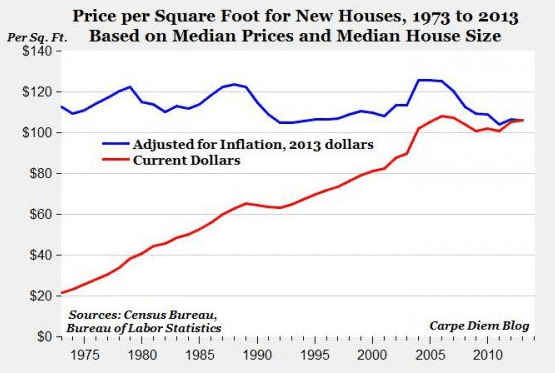
So the trend towards larger homes cannot be explained away through better value for your building dollar; North Americans have simply decided that we want larger houses, and are willing to pay much more for housing than we need to. With the data presented so far, we can throw together a rough estimate for the cost of building a home in 2013 compared to 1973 in the U.S., using today’s dollar value:
- Average House from 1973: $106/sq. ft. x 1,050 sq. ft. (1,000 sq. ft. less than 2013 numbers, as reported by AEI) = $111,300 USD in today’s dollars, or $147,745 CAD
- Average House from 2013: $106/sq. ft. x 2,100 sq. ft. = $222,600 USD in today’s dollars, or $295,490 CAD
 So Americans are now choosing to spend $147,745 CAD more for newly built houses on average, on top of what they were spending 40 years ago, simply to live in much, much larger houses. Can this expense be justified, given the decrease in average household sizes? Should North Americans take advantage of the ample space we have on this continent, and relatively flat change to building costs per-sq. ft. that this market has experienced for the past few decades? More importantly, do larger homes and living spaces increase our quality of life?
So Americans are now choosing to spend $147,745 CAD more for newly built houses on average, on top of what they were spending 40 years ago, simply to live in much, much larger houses. Can this expense be justified, given the decrease in average household sizes? Should North Americans take advantage of the ample space we have on this continent, and relatively flat change to building costs per-sq. ft. that this market has experienced for the past few decades? More importantly, do larger homes and living spaces increase our quality of life?
Each of these nations are ranked within the top 27 of the Economist Intelligence Unit’s Where to Be Born index (2013 rankings), with both Sweden and Denmark beating Canada’s 9th-place ranking. Averaged out, houses in these countries are 39% smaller than Canadian houses, and the average resident lives in a space 28% smaller than Canadians live in. Denmark is by easily the closest to Canadian living space standards among these 7 countries, but still has 24% smaller houses and 10% smaller living spaces than Canadians do on average.
Controlling Home Sizes
It is clear that Canadians on average can afford to massively downsize, as our allotment of average sq. ft. of both house size per-person and residence size per-person is among the highest in the world. Unless Canadians are twice the size of citizens of Italy, Sweden, Spain, and the U.K., this distribution doesn’t appear to make much sense, and also puts Canadians at an economic disadvantage, as we purchase much more square footage than we need, significantly increasing the average costs of home ownership. The second part of this article will be posted next Friday, December 11, 2015 and focus on the solution to this financial burden.

